FREE Standard Shipping On All Orders $100 or More!*
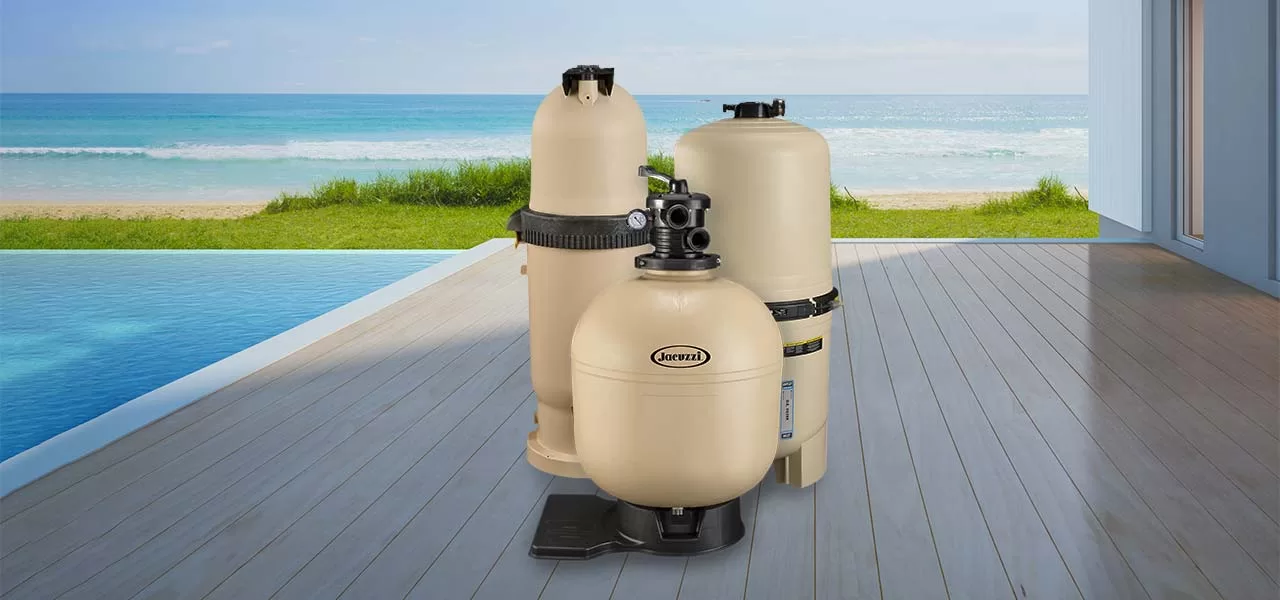
Best Pool Filter Type: Sand, Cartridge, or D.E.?
Selecting a properly-sized pool filter is the first and most important step to maintaining clean and clear pool water. Pool filters help your sanitizer focus on destroying bacteria by sifting dirt, debris, and contaminants out of the water. There are three types of pool filters, sand, cartridge, and diatomaceous earth (D.E.), and each one is excellent at its job. But is one better than the other? Is there a "best pool filter?" Let's break down each type of pool filter and determine if one rises to the top as the best pool filter.
Sand Filters

Sand filters, the most common type of pool filter, contain special silica sand inside the large tank. When water flows through the sand, it traps debris and particles, leaving clean water to return to the pool. Capable of filtering 20–40 micron-sized particles, sand filters are excellent at trapping larger debris, but are less effective at filtering smaller particles. Sand filters are low maintenance and also relatively inexpensive compared to other types of filters.
Continued use of a sand filter results in debris buildup and increases the pressure inside the tank. When the filter's pressure gauge reads 8–10 psi above the standard rate, it's time to backwash the filter. Backwashing the filter flushes out the debris buildup inside the tank and will drop the pressure gauge back to normal.
Pros
- Low maintenance
- Least expensive purchase cost
- Can filter large volumes of water quickly
Cons
- Not as efficient at filtering small particles as other types of filters
- Requires backwashing to clean the filter, which can waste water
- Sand needs to be replaced every 3-5 years
Cartridge Filters
Cartridge filters use a pleated filter cartridge inside the tank to trap debris and particles. As water flows through the cartridge, the pleats trap dirt and debris, before sending clean water back to the pool. Cartridge filters are more efficient at filtering small particles, 10–20 microns, than sand filters, and require less maintenance. They also don't require backwashing, which saves a significant amount of water over time.
Cleaning a cartridge filter involves removing the cartridges and gently hosing off the debris, whenever the pressure gauge reads 8–10 psi higher than normal. However, each time you clean a filter cartridge, you reduce its filtering ability. The more frequently a cartridge is cleaned, the sooner you will need to replace it. New filter cartridges cost approximately $30–$100 and should be replaced every 2–3 years.
Pros
- More efficient at filtering small particles
- Most energy efficient
- Require less maintenance than sand filters
- Do not require backwashing, which saves water
Cons
- Cartridges need to be replaced every 2–3 years
- Initial cost is higher than sand filters
- Can be less effective at filtering large volumes of water quickly
D.E. Filters
Diatomaceous Earth filters, better known as D.E. filters, use diatomaceous earth-covered grids to trap pool water contaminants. Just like sand and cartridge filters, the grids inside the filter tank catch debris as the water flows through the tank. D.E. filters are the most precise type of filter, trapping particles as small as 1–3 microns in size. They are also incredibly efficient and can filter large amounts of water in one cycle.
Similar to sand filters, cleaning a D.E. filter involves backwashing the debris out of the filter when the pressure gauge is 8–10 psi above normal. However, there is one additional step to complete a D.E. cleaning — replenishing the lost powder. After backwashing, you need to add more D.E. powder into your pool's skimmer to refill the filter tank, which can become costly if you backwash the filter frequently.
Pros
- Most efficient at filtering small particles
- Can filter large volumes of water quickly
- Easy to replace D.E. powder
Cons
- Require regular maintenance in addition to regular backwashing
- D.E. powder needs to be replenished after every backwashing
- Most expensive purchase cost
Filter Efficiency
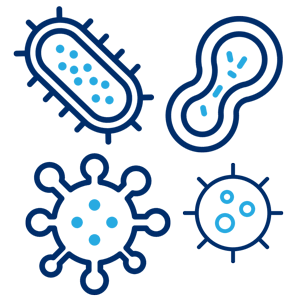
When it comes to efficiency, each type of pool filter has its own strengths and weaknesses. All filters work a bit better when they are slightly dirty, hence the range of micron-trapping ability. A clean sand filter may filter down to only 40 microns, but as dirt loads up in the sand bed, it may effectively trap particles in the 20 micron range. All filters will maintain clear water in a well balanced and clear pool, but only those that can trap very small particles can clean up adverse water conditions quickly.
For spring pool openings or algae blooms, for example, a D.E. filter can resolve these situations in 1-2 days, but sand filters can take over a week and require the use of a water clarifier or other chemicals. Other factors affecting filtering ability include the water flow rate and filter media age. High flow rates, higher than the recommended design flow rate, will produce poor filtration, pushing smaller particles right through the filter. As filter sand or filter cartridges age, they lose up to half of their dirt-trapping power and need to be replaced.
So, let's dive into the efficiency levels of sand, cartridge, and D.E. filters.
Sand Filters
Sand filters are known for their ability to filter large volumes of water quickly, making them an efficient choice for larger pools. However, they are less efficient at filtering small particles than other types of filters. Sand filters typically have a filtration rating of around 20–40 microns, meaning they can only remove particles of that size or larger. Smaller particles not trapped by the sand stay in your pool water.
Cartridge Filters
Coming in second place, cartridge filters are more efficient at filtering small particles than sand filters. They typically have a filtration rating of around 10–20 microns, which means they can remove smaller particles than sand filters. Cartridge filters are also better at maintaining a consistent flow rate, which can lead to more efficient filtration overall.
D.E. Filters
D.E. filters are the most efficient type of pool filter when it comes to filtering small particles. They typically have a filtration rating of around 2-5 microns, which means they can remove the smallest particles out of the three types of filters. D.E. filters are also efficient at maintaining a consistent flow rate, which can lead to more efficient filtration overall.
Filter Purchase Cost
D.E. filters are the most expensive type of filter, costing between $1,099 for the Hayward Pro-Grid 36 sq. ft. filter, and $1,819 for the Pentair Quad 100 sq. ft. filter. This price is mainly due to how many parts D.E. filters have, but also because they are the most efficient filter. Cartridge filters are the second most expensive filter, costing as much as $1,400 for the Jacuzzi JCF425 425 sq. ft. filter. Fewer parts, plus no need to buy a separate multiport valve, keeps the purchase cost of cartridge filters low. And finally, due to their simple construction and operation, sand filters are the most affordable, and thus the most common type of filter. Models range in price from $300 for the Raypak Protege filter, to $1,379 for the Pentair Triton II.
Media Lifespan
The tank of your pool filter can last 25 years or more, but the filter media, the stuff inside that does the filtering, will become worn out over time, eventually becoming evident in cloudy water and short filter cycles (time between backwash or cleaning). Tired filter media need longer filtration time and more frequent cleaning or backwashing to keep the filter pressure low. You'll also need more sanitizer, clarifier, and other chemicals to assist your ailing pool filter. The size of your filter will also greatly affect the filter media lifespan. If your filter is double the size, the filter media may last twice as long: six years for cartridges, 10 years for sand and 15 years for D.E. grids.
Media Replacement Cost
Changing filter cartridges is the easiest filter media replacement. Just open the tank and swap out the carts. Changing filter sand involves scooping out the sand by hand and pouring in new sand through the top access port. D.E. filter grid replacement involves opening the tank, and removing and cleaning the grids, followed by a complete disassembly and reassembly of the filter grid assembly. Replacing filter sand or the D.E. filter grids is more difficult and time-consuming (1-2 hours), but certainly DIY-friendly.
Sand
Cartridges
D.E. Powder
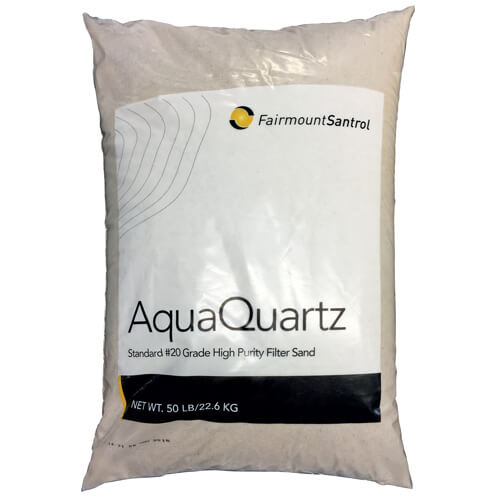
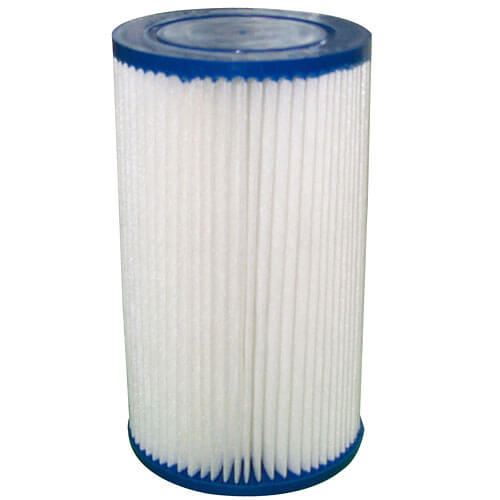
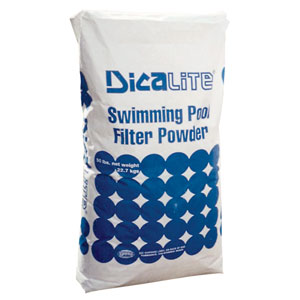
Sand
With continued use, filter sand will begin to lose its gritty texture and become smooth. This erosion of sand leads to less effective filtering and dirty water because the sand is no longer able to trap debris. When this starts to happen, you'll need to replace the filter sand. Pool filter sand typically costs $20 for a 50 pound bag, and most inground pool filters use about 300–500 pounds of filter sand depending on the filter size. So on average, replacing the sand in your sand filter will cost roughly $96–$160, every 3–5 years. Additionally, sand alternatives like Zeolite Sand, FilterBalls, and Filter Glass are available and can cost less than traditional sand.
Cartridge
As filter cartridges age, the fibers holding the pleats together start to break down and deteriorate. And the more deteriorated the cartridges become, the less effective the filter is. That's why it's important to replace filter cartridges every 12–15 cleanings, or every 3–5 years. Replacement cartridges can be purchased individually, or in packs of 4.
D.E.
D.E. filter grids are the fabric-coated plastic frames inside the filter tank. Over time, the stitching will unravel or holes can develop in the fabric. Not to mention the strain that poor water chemistry can put on the grids. Most D.E. filters have eight grids, and complete D.E. grid sets are available for $100–$150 or individually for around $20 each. Replacement D.E. or cellulose powder costs roughly $35 for a 25-pound bag.
Filter Water Usage
If you are located in a dry area with pool water use restrictions, your city may have already chosen your next pool filter for you. Cartridge filters are the most water-conscious filter and are preferred in drought-stricken areas, as they do not require backwashing.
D.E. filters are second on the list for water conservation, as they require minimal backwashing. D.E. filters can be "bumped" every few weeks to reduce the frequency of backwashing. A "bump" is a short, 10-15 second backwash that mixes up the dirt and D.E. powder. Sand filters, however, require more frequent and longer backwashing cycles, using more wastewater than other filter types.
Maintenance & Care
A sand filter is the simplest filter design, with fewer parts and less potential problems. It does, however, have a multiport or push-pull backwash valve, which often requires more maintenance than the filter itself. D.E. filters have the most internal and external filter parts and require annual removal, cleaning and inspection of the grid assembly. Which opens the door for more potential problems. Cartridge filters have a simple design with few parts. Therefore, it is less likely that a cartridge filter will break down or require frequent repairs.
At the end of the day, each type of pool filter has its own efficiency level when it comes to removing debris from the water. Sand filters are efficient at filtering large volumes of water quickly, cartridge filters are more efficient at filtering small particles, and D.E. filters are the most efficient at filtering small particles. When choosing a pool filter, consider the size of your pool, the level of usage, and the amount of debris in your pool to determine which type of filter will be the most efficient for your needs.